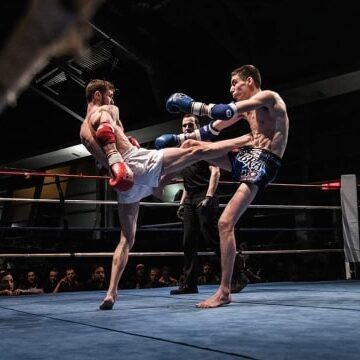
Kickboxing Vs Muay Thai: Which is Better?
If you want to learn a martial art that blends self-defense and full-body fitness, you may have considered both Muay Thai and kickboxing. Both styles have gained popularity, but choosing one over the other can be difficult. At Infinite Martial Arts & Fitness in Belleville, Ontario, we prefer Muay Thai as the better option for self-defense and fitness.
What is Muay Thai?
Muay Thai is a Thai martial art that dates back hundreds of years. It is also known as “The Art of Eight Limbs” because it uses strikes with hands, feet, elbows, and knees. Muay Thai offers a challenging workout that strengthens, stretches, and tests endurance.
What is Kickboxing?
Kickboxing merges punches and kicks from boxing with kicks and knee strikes from karate. It became popular in the 1970s as a workout and self-defense method. Although kickboxing provides a good cardio workout, it does not use as many strikes or movements as Muay Thai.
Benefits of Muay Thai
- Effective self-defense: Muay Thai is a highly effective martial art for self-defense. Students learn to defend themselves with strikes from all eight limbs, as well as grappling and clinching techniques. This makes Muay Thai a comprehensive self-defense option.
- Total body workout: Muay Thai requires strength, endurance, and flexibility. It offers a full-body workout that improves fitness.
- Mental benefits: Muay Thai trains the mind as well as the body. It demands discipline, focus, and determination and helps students build self-confidence and resilience.
- Cultural significance: Muay Thai preserves Thai tradition and culture. Practicing it offers an appreciation for Thai culture and history.
Ruleset for Muay Thai Competition
In amateur Muay Thai competition, matches consist of three rounds, each lasting three minutes with a two-minute rest in between. Points are awarded for strikes, kicks, knee strikes, and clinch techniques. A fighter can win by knockout, technical knockout, or decision of the judges.
The following techniques are allowed in amateur Muay Thai competition:
- Punching: strikes with the gloves
- Kicking: strikes with the shins and feet
- Knee strikes: knee strikes to the body or head
- Elbow strikes: strikes with the elbows
- Clinching: grappling techniques used to control the opponent
The following techniques are not allowed in amateur Muay Thai competition:
- Head-butting
- Biting
- Groin strikes
- Strikes to the back of the head or spine
- Intentional holding or grabbing of the ropes
Ruleset for Kickboxing Competition
In amateur kickboxing competition, matches consist of three rounds, each lasting two minutes with a one-minute rest in between. Points are awarded for punches, kicks, and knee strikes. A fighter can win by knockout, technical knockout, or decision of the judges.
The following techniques are allowed in amateur kickboxing competition:
- Punching: strikes with the gloves
- Kicking: strikes with the feet
- Knee strikes: knee strikes to the body or head
The following techniques are not allowed in amateur kickboxing competition:
- Elbow strikes
- Clinching
- Head-butting
- Biting
- Groin strikes
- Strikes to the back of the head or spine
- Intentional holding or grabbing of the ropes
Why Infinite Martial Arts & Fitness Chooses Muay Thai
At Infinite Martial Arts & Fitness, we choose Muay Thai for its effectiveness in combat, its also a better combination of self-defense and fitness. We believe Muay Thai provides a more comprehensive workout and better self-defense skills than kickboxing. Our experienced instructors will guide you in developing your Muay Thai skills and reaching your fitness goals.
In conclusion, if you want to learn a martial art that blends self-defense and full-body fitness, try Muay Thai at Infinite Martial Arts & Fitness in Belleville, Ontario. Our classes suit both beginners and experienced martial artists, and will help you improve your skills and reach your fitness goals.
